Are you a Quiet Speculation member?
If not, now is a perfect time to join up! Our powerful tools, breaking-news analysis, and exclusive Discord channel will make sure you stay up to date and ahead of the curve.
The set release is nigh! With all of Ravnica Allegiance spoiled, speculation can end and brewing begin. I'm pleasantly surprised by all the potential Modern playables. This expansion might not go down in history like Khans of Tarkir, but I expect plenty of cards to see play, if only because they're too interesting not to brew with.
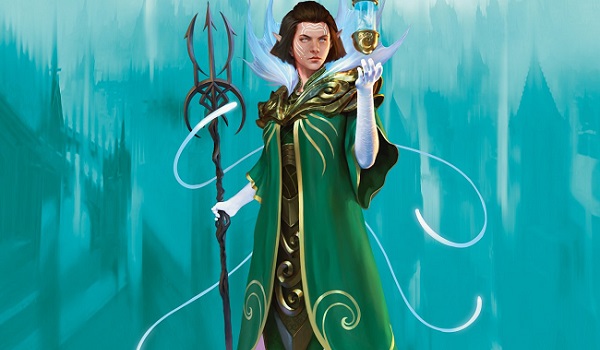
However, not all potential cards were designed equal. So far, I've covered some unique and potentially gamechanging cards as well as niche but powerful cards. This week is for cards that may offer something unique or powerful-seeming, but in the context of Modern, may not live up to that potential.
Repudiate // Replicate
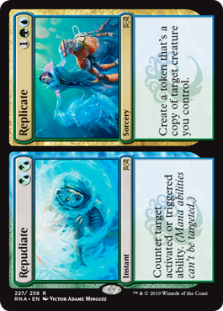 I will be focusing on Repudiate // Replicate for this section, but I have the same arguments for Modern prospects Incubation // Incongruity and Revival // Revenge. These are spells with decent effects and very attractive flexibility defeated by context.
I will be focusing on Repudiate // Replicate for this section, but I have the same arguments for Modern prospects Incubation // Incongruity and Revival // Revenge. These are spells with decent effects and very attractive flexibility defeated by context.
The individual effects and their associated mana costs aren't enough to warrant Modern play. The flexibility of being a split card with hybrid mana costs makes a promise to make up for the effect, but ultimately, it's not a promise that can be kept. Even with the additional benefit, no deck wants these cards.
Collective Comparison
Modal and split cards almost always cost more than the individual effects are worth in constructed formats. Their flexibility makes up for the cost because they free up spell slots for other spells. Individually, drawing a card worth two mana, giving creatures lifelink is barely playable, and returning attacking or blocking creatures to the top of the library is marginal. Put all these effects together and Azorius Charm is a defining card in Standard. The value of flexibility makes up for individual weakness in Standard.
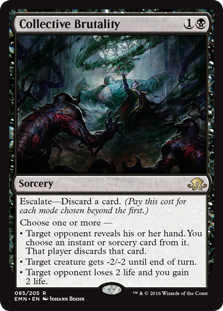 The same can't be said in Modern, where mana cost and effect impact are king. Decks are more powerful and streamlined than in Standard, so there's less need for flexibility. Some modal/split spells see niche play, like Orzhov Charm for Death's Shadow or Dusk /// Dawn in Death and Taxes. However, I can only think of two that see regular play: Cryptic Command and Collective Brutality. The former sees play in control for its power, while the latter is more widespread and applicable to this discussion.
The same can't be said in Modern, where mana cost and effect impact are king. Decks are more powerful and streamlined than in Standard, so there's less need for flexibility. Some modal/split spells see niche play, like Orzhov Charm for Death's Shadow or Dusk /// Dawn in Death and Taxes. However, I can only think of two that see regular play: Cryptic Command and Collective Brutality. The former sees play in control for its power, while the latter is more widespread and applicable to this discussion.
The reason for Brutality's ubiquity is that it's cheap. In the past, I've expressed dissatisfaction with Brutality because its individual effects are so small. What I had missed was how valuable having all three for no additional mana would be. Discarding cards to get those effects is the real power of Brutality, as it synergizes so well with all the graveyard strategies. Thus, the new split cards need to synergize well or be overwhelmingly powerful to make it in Modern.
Niche at Best
Repudiate has several problems indicative of the whole group. Its effect is worse than the already existing Trickbind, because it costs more colored mana and doesn't have split second. If a deck wanted the effect, it would already have it, and Trickbind doesn't see any play.
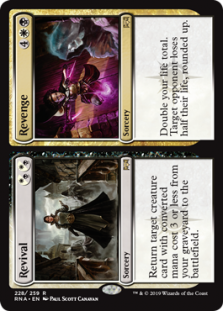 The only thing Repudiate has over Trickbind is that it could be played in mono-green decks. However, why would any deck want to? The effect is niche at best. Prior to Deathrite Shaman being printed Stifle saw a lot of Legacy play in RUG Delver to kill fetchlands. Since then, it hasn't been good enough for widespread play. Why would a deck play a worse version of an unplayable card?
The only thing Repudiate has over Trickbind is that it could be played in mono-green decks. However, why would any deck want to? The effect is niche at best. Prior to Deathrite Shaman being printed Stifle saw a lot of Legacy play in RUG Delver to kill fetchlands. Since then, it hasn't been good enough for widespread play. Why would a deck play a worse version of an unplayable card?
The addition of the other half of the spell might be enough, however they're also not good enough. Any deck that wants to copy its own creatures would just play Phantasmal Image for cheaper and with Collective Company/Aether Vial synergy. If I want an inefficient but flexible Stifle, I could have Nimble Obstructionist.
They Don't Belong
Revival has the best chance of eventually making it to Modern as an incremental upgrade to Claim /// Fame. However, the odds aren't favorable. Reanimation in Modern is either interested in big creatures or Death's Shadow, and Revival can't do the former and is inefficient at the latter. In short, these effects already exist on better cards in Modern and every deck that wants them has them. There's no reason to pick something worse for niche benefits.
Electrodominance
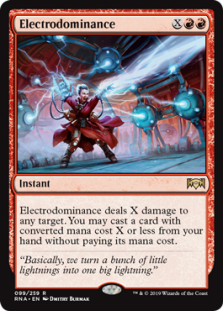 If this is where Wizards' heads are, then Lavinia, Azorius Renegade starts to make sense for Standard. That aside, Electrodominance has had an electric effect on spoiler season. Everywhere I've looked, I've seen players trying to use its power to do broken things with uncosted suspend cards. I'm not so on board.
If this is where Wizards' heads are, then Lavinia, Azorius Renegade starts to make sense for Standard. That aside, Electrodominance has had an electric effect on spoiler season. Everywhere I've looked, I've seen players trying to use its power to do broken things with uncosted suspend cards. I'm not so on board.
Here We Go Again
Forgive my cynicism, but I've been down this road before. Everyone was all over As Foretold after Amonket, but despite all the effort, it never went anywhere. That card had the added benefit of being persistent and scaling over the course of a game. If Modern can't use all the free mana from As Foretold, why would the one shot effect of Electrodominance make it?
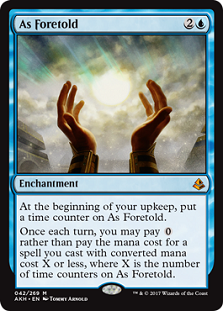 The obvious answer is to play Ancestral Visions or Living Ends from hand rather than leaving them stranded. This is fair, but Modern already had that in the Aether Revolt expertise cycle. In particular Kari Zev's Expertise was supposed to save Living End decks from niche play and didn't.
The obvious answer is to play Ancestral Visions or Living Ends from hand rather than leaving them stranded. This is fair, but Modern already had that in the Aether Revolt expertise cycle. In particular Kari Zev's Expertise was supposed to save Living End decks from niche play and didn't.
The only advantage that Electrodominance has over anything that has come before is being cheaper. This isn't nothing, but what does it actually mean to Wheel of Fate, Restore Balance, or Ancestral Vision on turn two? How does a deck use these effects this early to win the game?
Strategic Problem
Ultimately, this is the problem all these not-cascade cards have struggled with. The card power and synergy are there, but they can't take full advantage of them. In order to get these effects, they play a lot of situational and/or redundant enabler cards. The various As Foretold decks either went the combo route with all the card draw, or prison with Greater Gargadon and Ensnaring Bridge, and it wasn't good enough because there was too much air, too much durdling, and it took too long. It didn't matter if they were capable of drawing all of the cards or sweeping the board a few times if they couldn't actually close the game. The problem lies on the strategic level of being overly complicated and inefficient decks, and not with a lack of enablers.
Solution Elusive
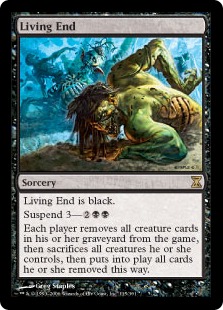 Since Electrodominance doesn't fix this fundamental strategic problem, it won't rescue Blue End or As Foretold prison from Modern's fringe. I'm not certain what card actually could. The solution to being somewhat clunky and being unable to take advantage of all the cards a deck can draw is typically more mana, but fast mana isn't a thing in Modern.
Since Electrodominance doesn't fix this fundamental strategic problem, it won't rescue Blue End or As Foretold prison from Modern's fringe. I'm not certain what card actually could. The solution to being somewhat clunky and being unable to take advantage of all the cards a deck can draw is typically more mana, but fast mana isn't a thing in Modern.
Arclight Speed Limit
The main appeal of As Foretold decks was the ability to draw many cards quickly, and Modern now lets you do that and play a good deck to boot. I'd argue that the actual gameplan of Arclight Phoenixdecks is to draw lots of cards. Having cantripped through their decks, players find a payoff or several and win thereafter. Players that want a mana sink that also draws more cards for Phoenix could do worse than Electrodominance in that role. It's not very good or efficient compared to everything else in the deck, but it could happen.
Gruul Spellbreaker
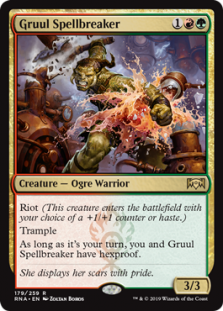 The next card is a creature with multiple problems. Gruul Spellbreaker looks so close to making it in Modern. Being a three mana 3/3 with haste or a 4/4 without is close to playable in the right deck or with the right abilities, as demonstrated by Mantis Rider and Loxodon Smiter. But therein lies the problem. Spellbreaker's other abilities aren't relevant enough in Modern, and even if they were, the right deck for it is the wrong deck for Modern.
The next card is a creature with multiple problems. Gruul Spellbreaker looks so close to making it in Modern. Being a three mana 3/3 with haste or a 4/4 without is close to playable in the right deck or with the right abilities, as demonstrated by Mantis Rider and Loxodon Smiter. But therein lies the problem. Spellbreaker's other abilities aren't relevant enough in Modern, and even if they were, the right deck for it is the wrong deck for Modern.
Belonging Problem
The obvious place to start is to look for a place to live. On the basis of stats and cost, it seems natural to pair Spellbreaker with Bloodbraid Elf to have six power of hasty creatures attacking turn 4. This isn't the worst cascade. However, Jund would never play Spellbreaker. To get a space in Jund, a creature either needs to provide additional value or be incredibly efficient. 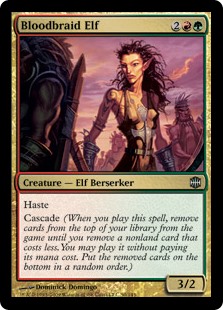 As it doesn't have built in card advantage or value like Dark Confidant or Scavenging Ooze, the ogre is just a beater, which is the same job Tarmogoyf holds. Given that Goyf is cheaper and frequently bigger than Spellbreaker, it wins the fight easily.
As it doesn't have built in card advantage or value like Dark Confidant or Scavenging Ooze, the ogre is just a beater, which is the same job Tarmogoyf holds. Given that Goyf is cheaper and frequently bigger than Spellbreaker, it wins the fight easily.
If not Jund, the only option is for Gruul-colored aggressive decks. This means either GR Eldrazi or Zoo. The problem is that neither deck is a deck in Modern anymore. Zoo hasn't been a serious contender in years, while GR Eldrazi had some success this time last year it has virtually disappeared. The three-drop spot was so crowded anyway that I can't imagine Spellbreaker making it into Eldrazi in the first place. That leaves Zoo, which isn't a deck in Modern anymore.
Zoo's Strategic Stagnation
There was a time that Zoo was the best deck in Modern. That time was 2011, right before Wild Nacatl got banned. By the time that was undone in 2014, Modern had passed Zoo by, and the deck has failed to have any significant impact since.
 The problem with Zoo is that it's the definition of a straightforward aggro deck. It just plays the best cheap attackers, turns them sideways, and hopes that plus some burn is enough. Even in 2014, pure Burn did that too, but far more efficiently; Affinity did that more explosively, with flying, and featuring an infect backup plan. Today we have decks that randomly dump free 4/4's into play turn 1 and follow that up with 1 mana 5/5's. Zoo's strategy is from a time when Wizards didn't push the bar on creatures, and is now too archaic to survive. If Zoo in any form wants to come back, it will take a major overhaul, and a three-mana, 3/3-4/4 beater isn't going to cut it.
The problem with Zoo is that it's the definition of a straightforward aggro deck. It just plays the best cheap attackers, turns them sideways, and hopes that plus some burn is enough. Even in 2014, pure Burn did that too, but far more efficiently; Affinity did that more explosively, with flying, and featuring an infect backup plan. Today we have decks that randomly dump free 4/4's into play turn 1 and follow that up with 1 mana 5/5's. Zoo's strategy is from a time when Wizards didn't push the bar on creatures, and is now too archaic to survive. If Zoo in any form wants to come back, it will take a major overhaul, and a three-mana, 3/3-4/4 beater isn't going to cut it.
Otherwise, Irrelevant
I've skipped over the non-riot abilities on Spellbreaker so far because they're not going to 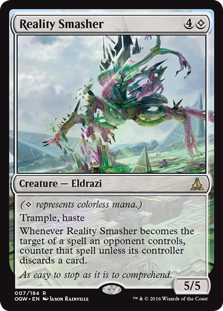 help or hinder its playability. Trample is mostly irrelevant on a lower-mid sized creature since it's only getting blocked if it can be killed anyway and that's not too hard today. Trample isn't why Reality Smasher is played.
help or hinder its playability. Trample is mostly irrelevant on a lower-mid sized creature since it's only getting blocked if it can be killed anyway and that's not too hard today. Trample isn't why Reality Smasher is played.
The conditional hexproof is interesting, but it isn't good enough. Most decks will be willing to wait to kill Spellbreaker anyway as long as they can kill other threats. If the controller always had hexproof that might be good enough, but only having it on their turn means it only affects Vendilion Clique, Blessed Alliance, and Settle the Wreckage, none of which see much play. Thus, the utility is niche at best.
Prime Speaker Vannifar
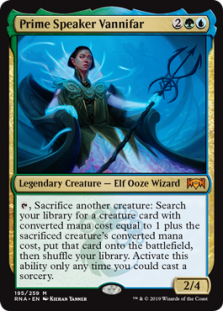 Finally, there's the newest broken-card-with-legs, Prime Speaker Vannifar. Time Spiral's Magus cycle of Vintage-cards-on-legs are Vannifar's direct ancestors. While Magus of the Moon and Magus of the Tabernacle have seen play, the Magi with activation costs (like Vannifar) have had no real impact in the format.
Finally, there's the newest broken-card-with-legs, Prime Speaker Vannifar. Time Spiral's Magus cycle of Vintage-cards-on-legs are Vannifar's direct ancestors. While Magus of the Moon and Magus of the Tabernacle have seen play, the Magi with activation costs (like Vannifar) have had no real impact in the format.
Vannifar looks like a better deal. For starters, she can be found off Chord of Calling on the end step and then combo off on your own turn. This power being why Splinter Twin got banned, it's a possibility to look into. Her activation is also manaless, unlike Birthing Pod. This means Vannifar can do every combo that Pod did, but more efficiently, theoretically opening up new combo or value chain possibilities. It's not surprising that Pod stalwarts are salivating over the prospect of their deck being resurrected.
Out of Her Prime
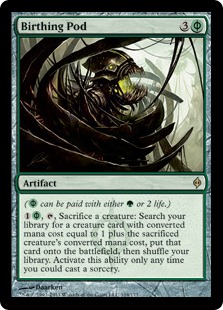 Being fetchable is no small thing, and neither is the manaless activation. However, the problem of being a creature still hangs on Vannifar; while I'm sure she'll see play in Modern, her true home will be Commander.
Being fetchable is no small thing, and neither is the manaless activation. However, the problem of being a creature still hangs on Vannifar; while I'm sure she'll see play in Modern, her true home will be Commander.
Birthing Pod was a good card because it could be played turn 2 off a single Bird, used immediately (mana provided), and was immune to (almost) all maindeck removal. None of these things are true of the Prime Speaker. This is by design: the entire point of stapling broken spells to creatures is to make them more vulnerable to removal and slow down their effects.
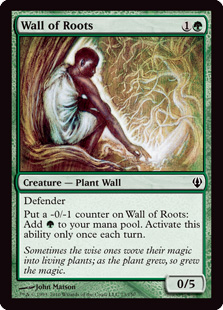 Chording for Vannifar with the intention of going off after untapping would be a sound plan if it could be defended. However, that Chord requires seven mana, and while it's possible with two Birds of Paradise and a Wall of Roots on turn three, it doesn't leave any mana open to protect the Chord or the Vannifar. Kiki-Chord worked for Jeff Hoogland and almost nobody else for a reason.
Chording for Vannifar with the intention of going off after untapping would be a sound plan if it could be defended. However, that Chord requires seven mana, and while it's possible with two Birds of Paradise and a Wall of Roots on turn three, it doesn't leave any mana open to protect the Chord or the Vannifar. Kiki-Chord worked for Jeff Hoogland and almost nobody else for a reason.
The Prime Speaker needs protection because there is removal everywhere. The only commonly-played-maindeck card that could remove a resolved Pod was Maelstrom Pulse, which was only played in Jund. At instant speed alone, Vannifar has to contend with the very commonly played Path to Exile, revolted Fatal Push, Dismember, Lightning Axe, Assassin's Trophy, and occasionally Terminus.
The Real Question
Given that Pod was cheaper and virtually guaranteed to survive and Vannifar isn't, it appears that the only reason to consider the card is the potential to cast Chord on the end step, and win via combo in turn four's main phase. However, why bother? Chord players can already do that on turn three in Counters Company with Devoted Druid and Vizier of Remedies. It may require more cards in the actual combo, but setting up Vannifar requires at least as many. It's also not particularly burdensome for a deck with Collected Company. If the Company deck isn't good enough, why would the slower and thus more vulnerable Vannifar deck supersede it?
Quick Hits
Finally, here are some thoughts on a couple other cards that I don't think warrant an entire section.
- Absorb - Despite appearances, this is quite playable in UW Control. The cost isn't burdensome and Logic Knot is often a three mana spell anyway. More importantly against burn incidental lifegain on a counter can be backbreaking much the same way Lightning Helix can be.
- Hero of Precinct One
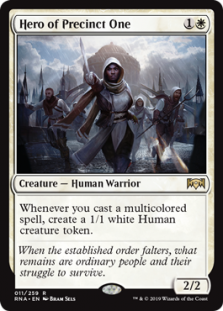 - The deck that wants this card does not exist because there aren't enough cheap multicolored spells to emulate Young Pyromancer. I'd like this not to be the case because the greater flexibility is very appealing.
- The deck that wants this card does not exist because there aren't enough cheap multicolored spells to emulate Young Pyromancer. I'd like this not to be the case because the greater flexibility is very appealing.
Speculation's End
I look forward to seeing what other players make of Ravnica Allegiance in the coming weeks. I'll also take this opportunity to remind everyone, as I always do, that despite the upcoming banlist announcement and the hype around it, don't fall for any speculation. I believe the correct prediction is always no changes. That said, we'll all find out if I'm wrong about that this time next week.




I can think of at least one other modal spell seeing play in modern : Kolaghan’s Command.
As for Electrodominance, I saw a lot of Jeskai players being pretty interested with it as well, for some instant speed PW for instance.
Thank you for your regular analysis btw.
Oh yeah, forgot about that one. Having three Modern relevant abilities also makes a modal spell playable.
That seems really questionable to me. What’s the benefit of a more expensive planeswalker at instant speed, other than playing said walker at instant speed? Unless you’re doing it in your mainphase, you can’t use the walker and it’s not like there’s no instant speed removal for walker’s available.
Playing Teferi with Electrodominance enables you to kill a big guy, and then untap with all your mana to protect it. Playing a walker at instant speed enables you to play a wrath right when you untap to make sure it won’t die to the ennemy board for instance. How many instant speed removals can you think of for PW in modern though ? I can only think about Assassin’s Trophy.
True.
However. To do that requires having six+ mana available with both the Electrodominance and ‘walker in hand. The question is why spend all that mana when I could have killed the creature with Path/Oust then played my walker and got value earlier? For the same price I could also play Jace, Brainstorm Terminus to the top of my deck then on the opponent’s attack step Opt and Terminus them. ‘Dominance seems like a lot of effort just to not tap mana on your turn.
Trophy is the only option that sees play, though Bedevil *might* make it. Your walker can still be Bolted, and if all that happens on end step then you get no value from the walker and it’s just a waste. The same result may happen if you mainphase said walker, but at least you can use it once.
Vannifar I disagree with you on a bit.
Your points make a lot of sense but she is also being played in a strategy that is going to demand alot of removal every turn which taxes their answers pretty heavily
Secondly she works pretty decently without even comboing as a straight value play.
She is the only one on this list that I think is likely to have even a medium impact and it’ll be fringe.
Also I have a deck that can use repudiate/replicate. But noone else plays my deck and it’s not like I’ve won anything more than a few ~30 person FNM’s with it
The same things were generally true of Kiki-Chord lists, and they didn’t work out. The problem with engine decks is that if the engine gets disrupted the whole thing turns into a mediocre pile of medium-sized creatures opposing decks may not have to care about. Successful engine like Survival of the Fittest and Birthing Pod have been cheap and hard to kill.
I hope you’re wrong about Prime Speaker Vannifar. Obviously POD fans are getting excited about this card, but comparing it to Devoted Druid is a little inaccurate imo.
First of all, the Druid deck has very few ways of grinding through removal, whereas “kiki-pod” back in the day was actively good at that. There’s no reason why Prime Speaker has to be an all-in combo deck. Hatebears exists as a deck (although not being brilliant), and you could (and probably should) take a similar route with Vannifar. Playing a slightly grindier toolbox deck with a combo finish seems better than trying to race storm with a 4-drop. Devoted Druid decks try to race, not interact. That won’t be the same for Kiki-pod, at least that’s my gut instinct.
The second point which is overlooked, is that you can give Vannifar haste. It’s pretty easy to go T1 Dork, T2 “something that will give Vannifar haste”, T3 Vannifar with haste, win. That’s a similar number of cards to Devoted Druid, and similar speed. So there’s the potential at least to be comparable to Devoted Druid, and also the potential to be grindier (the combo pieces for the kiki deck require Renegade Rallier and Restoration Angel, which are already grindier by design).
That’s why I think the comparison with Devoted Druid is inaccurate. Thats not to say Vannifar isn’t without fault or that it’ll even be a deck worth mentioning – just that I felt the analysis was a little inbalanced.
You aren’t wrong.
However the catch is that Collected Company forgives a multitude of sins. There’s very little grindier than the Company, Eternal Witness, and Tireless Tracker with Gavony Township backup plan that Counters Company includes. When something goes wrong with your plan in current Kiki-Chord decks, you’re playing off the top of your deck. The Company decks can just Company themselves back into the game. My point is that everything about the Vannifar plans looks like a more vulnerable and slow version of Counters.
Your sequence is true, however Company gives the Druid decks the option to simplify to turn 2 Druid, turn 3 Company find the combo or get a lot of value. It’s more versatile.